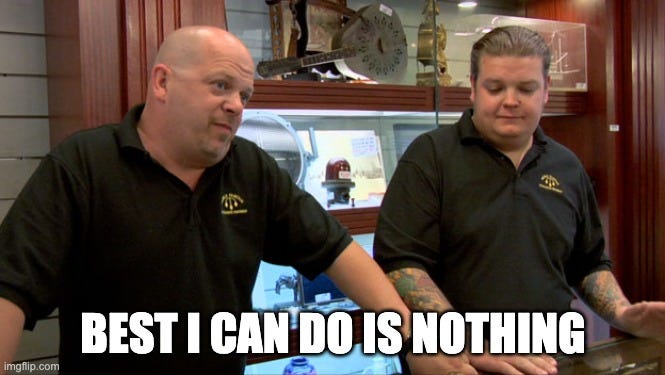The year is 1813. It is the beginning of the 19th century - an epoch of steam powered ships, life-like automatons and all kinds of mechanical wonders. A little known inventor called Charles Redheffer has made his way to New York. His goal - to market a new type of machine, which he designed.
It’s not just any ordinary machine. This one is very special. In fact it’s nothing short of miraculous. You see, once set in motion it never stops, or so Redheffer claims.
The design was simple. It seemed that a long shaft supporting a few turning gears was all it took to achieve the impossible and people from across the city came to witness the wondrous invention.
Despite simple appearances, the consequences Redheffer’s machine were unfathomable. Free energy is something that would change the face of our civilization forever in unimaginable ways.
Redheffer’s popularity grew. The men were jealous, and women were impressed by his… machine. His finances followed as the audience was not discouraged by high viewing prices. However, not everyone was equally infatuated. Among those who weren’t was Robert Fulton - a steamboat pioneer.
You see, Redheffer displayed his machine in a multi-storied building, and placed it behind barred windows. He deliberately obscured some elements, making it difficult to examine the contraption directly. Yet, an engineering savant like Fulton knew exactly what to look for.
He expected the see and hear the cogs turn in a smooth, regular motion as they do in typical engines. However, in Redheffer’s machine all that was off. The incredible engine that defied all odds and promised free energy to the world, reminded Fulton too much of… a crank driven mechanism.
Smelling bullshit, Fulton challenged Redheffer, publicly. The inventor agreed to an investigation and with little effort Fulton discovered the truth. The main shaft of the machine led to the second floor of the building. There, in one of the rooms, an old, starved, possibly imprisoned man turned a handle that powered the engine of wonder - the illusion was shattered.
Redheffer’s run ended in a spectacular disaster, making him pull off a disappearing act. As with all miracles, his also turned out to be a fraud.
Now, did Redheffer exploit people’s ignorance and gullibility to swindle them out of their money? Yes, and maybe that can be forgiven.
But did he also try to violate the first and second law of thermodynamics by trying to magically reuse energy without putting in any work and making it last forever.
Yes, and that is unforgivable.
Ok, in all fairness, in 1813 no one knew about the laws of thermodynamics. As we’ve seen in the previous episode, that understanding came about a bit later.
This, of course, didn’t stop others from trying the same as decades and centuries went by. Whether driven by greed, ignorance or insane ambition, all were unsuccessful, if I really need to add. If you were thinking of building a perpetual machine yourself, dear reader, then let this be a warning.
But I see you’re confused.

Nothing is good
We’ve explored how the introduction of the concept of energy and its conservation obliterated the idea of the “heat fluid“ called caloric once and for all.
That theoretical void allowed the idea of heat-is-motion to expand in its place. It seemed ever more convincing that heat was the manifestation of particles of matter bouncing around to the rhythm of pure chaos. Normal people would be happy with this explanation and just go about their day, warming themselves in the heat of a fireplace and having a great time.
However, for the scientific minds of the time all of that seemed pretty vague and somewhat unsubstantiated. In response, they channelled their inner Jordan Peterson and started asking: what do you mean by “particles“ and “bouncing around“? What do you mean by “mean“?… Nah, that last one is just pure, unhinged Bucko.
Nonetheless, a scientific discussion, especially about a novel idea, is not for the faint of heart. To be accepted as mainstream, this idea needs to be locked in a cell, starved, sleep deprived and interrogated to death several times over and then some more.
One of those up to that task was none other than Captain Thermodynamics - Rudolf Clausius, which we’ve already met here.
Because of the works of Mayer and Joule, he was ok with the fact that heat can be converted to work and vice-versa. What he was not ok with is that we didn’t know how, exactly. Could we really tell what happened inside those bodies, that made this possible?
On top of that, he was really bothered by Carnot’s statement, that heat flows from hot to cold bodies, but not the other way around, unless someone or something makes an extra effort. It felt wrong to him, that heat-to-work conversion (Clausius calls it the first fundamental theorem) and heat flow seemed like two disjointed statements.
Ok, let’s pause for a moment. We’ve been talking about engines, heat and work for several episodes now. This might be getting painfully boring to you, my gentle reader and I understand. What about quantum mechanics and black holes and living in a simulation, right?
Well, I have three answers to that.
First, all of that will come in due time. Second, very little science communication focuses on the motivation behind entropy and scientific concepts, in general. I intend to fill those holes and I’d appreciate if you’d like to watch me do that. Finally, I find that boring questions can have fascinating answers, as we will see in a moment.
Anyway, back to our regular program. Clausius had this to say about Carnot’s work:
“…the theorem, is incomplete, because we cannot recognize therein, with sufficient clearness, the real nature of the theorem, and its connexion with the first fundamental theorem.”
The nature question seemed especially elusive. Clausius proposed that all of this heat migration is a result of the constituents of matter changing distances with respect to each other and rearranging their positions, or:
“These processes always admit of being reduced to the alteration in some way or another of the arrangement of the constituent parts of a body. For instance, bodies are expanded by heat, their molecules being thus separated from each other…”
That’s great, but that’s just a lot of hand waving. Eventually it comes down to: equation or GTFO, and Clausius wasn’t planning on going anywhere.
He looked at Carnot’s engine (or cycle if you don’t like engines, but then who are you as a person, really…) from every possible angle and saw that it’s efficiency could be expressed as:
1 - QC / QH
where QH is the heat injected into the engine from the hot source and QC is the heat ejected from the engine into the cold source, at the end of the cycle.
But, with some more effort, that same thing could be represented as:
1 - TC / TH
where TH is the temperature of the hot source and TC that of the cold source.
This means that TC / TH = QC / QH and:
So, for a perfect cycle, like Carnot’s, all of those heat-over-temperature entities sum up to nothing. Perfect here means that it is reversible and that, in turn means, that you can run it both ways: hot-to-cold or cold-to-hot (refrigerator) and not lose anything in the process.
What is a non-perfect cycle/process, then? It is absolutely everything else in this Universe, that isn’t connected with the name “Carnot”. For all of that this sum cannot be nothing - it must be something.
But something like what?
Something is not good
So let’s say a hot body with TH is heating a colder body TC. The hot one gives some ΔQ of heat to the cold one. Let’s make ΔQ a positive number and also small, so that the heat transfer doesn’t significantly change the temperature of either body.
Now, the hot one experiences -ΔQ / TH during this process (minus sign because it loses heat). The cold one experiences ΔQ / TC. Since TH is larger than TC, the following sum is positive:
ΔQ / TC - ΔQ / TH
Ok, this is fine, but no cigar, yet. This tells us that in some cases some Q / T becomes positive, which is nothing new. So, just maybe, we can get it to be negative? Let’s make sure the Universe isn’t watching and do just that.
Let’s demand that the heating process runs in reverse. We would say that the cold body is giving away the heat to the hot one, so we would just reverse the sign in front of ΔQ and the whole thing:
- ΔQ / TC + ΔQ / TH
would become negative.
This looks ok on paper, but there are issues.
Obviously cold things heating hot things doesn’t seem to happen on its own, ever. You could stare at your latte macchiato since the beginning of time and it would remain as cold as ever, eventually beginning to stare back.
Also, what does it mean for the sum of heat over temperature in a process to be negative? Carnot’s cycle is already reversible and there the sum is 0. Does this mean that cold heating hot is even more reversible? Wut?
It seems we cannot leave this sum negative and just walk away, unless we want a call from the thermodynamics police. We are forced to make it, at least, nothing.
We actually saw this happening when Carnot was running his engine like a refrigerator. He was able to put in some extra effort and only then he made the cold body heat the hot one. Since work and heat are equivalent, that extra work could also be expressed as some other Q / T. In this idealized case, it balanced everything else perfectly and we got nothing overall.
In reality though, that is not possible. Pushing, pulling, shooting lasers or splitting atoms always leaves a trace behind. There’s always a Q / T stench coming from somewhere, that we cannot get rid of, no matter how hard we try.
In general, we can say that:
Right, this thing seems really important. We need to give it a name. Clausius came up with this:
Now the effect of heat always tends to loosen the connexion between the molecules, and so to increase their mean distances from one another. In order to be able to represent this mathematically, we will express the degree in which the molecules of a body are separated from each other, by introducing a new magnitude, which we will call the disgregation of the body, and by help of which we can define the effect of heat as simply tending to increase the disgregation.
Disgregation is probably the worst naming of anything ever and this is the first, and last time we are using that word. After a few iterations and introducing a bunch of even more confusing terminology, like ergons, he landed on entropy to make it sound similar to energy. The name stuck.
With this, Clausius bridged the gap that got him started on this journey in the first place. Work to heat, hot to cold and back again, could be now linked with entropy. Not only did he connect seemingly separate phenomenons in thermodynamics mathematically, he also showed why things tend to happen in only one direction, if left alone.
He finalized his conclusions with the most powerful one-two strike in history of science:
The energy of the universe is constant.
The entropy of the universe tends to a maximum.
Don’t breathe
Today, entropy is a nasty word. It makes people confused, agitated and generally triggered. There are reasons for this.
Quantities like Q / T are painfully abstract and escape the imagination. It also doesn’t help that there are several different definitions of entropy going around (which we will explore in due time). There’s the thermodynamical, which we’ve just seen. However’s there also a statistical take, another one coming from information theory and, of course, one from quantum mechanics. For example, in a statistical context:
…entropy is a measure of the number of possible microscopic states (microstates) of a system in thermodynamic equilibrium, consistent with its macroscopic thermodynamic properties…
or in information theory:
…the entropy of a random variable quantifies the average level of uncertainty or information associated with the variable's potential states or possible outcomes…
All point in the same direction, but it’s easy to miss, given how each is stated.
There’s a story about Claude Shannon (author of the theory of information entropy) talking to John von Neumann (author of the quantum mechanical entropy), asking him what to call his newly invented concept. Neumann tells him to call it entropy because no one knows what that really means and that should make him win any arguments that might arise.
Conventionally, we label entropy with the capital letter S. The equation:
is simple and short-to-be-almost-silly looking, yet it is probably the most consequential formula in physics. Why? Because it tells us the fate of the Universe.
As Lord Kelvin realized, everything that happens will make ΔQ / T of the Universe increase. Galaxies colliding, black holes evaporating and cows farting - all contribute. Even if it decreases in some place, it needs to increase in some other.
Take us humans, for example. Evolution made our bodies and those of every living being fight really hard to decrease entropy locally. For all intents and purposes we should’ve eroded away like a rock in the rain or expanded into the atmosphere like air in a popped balloon. Everyday we are fighting a battle to not get Q / T all over the place. However, at the end of the day, every breath you take and every move you make, increases entropy. In fact, even if you do nothing, you are still a part of the problem.
Eventually this will lead to the heat death of the Universe. Given enough time, all the hot things will heat the cold things and everything will break down. No planets, no stars, no galaxies, no black holes and even no Game Of Thrones spin-offs. The Universe will become a smeared out, cold void, where nothing happens ever again. In a way, we are really lucky to live in a time when things tend to occur.
To think all this because someone wanted to make the steam engine a little bit better.





